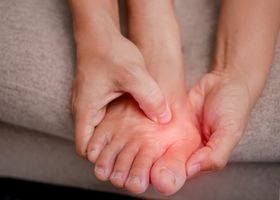Treatment of Plantar Fibroma: Exercises, Insoles, and More
Updated August 4, 2025

A plantar fibroma is a rare growth in the plantar fascia, the thick band of tissue at the base of the foot. Though benign, this growth continues to increase in size, causing pain. This can make it difficult to perform ordinary activities of daily living like standing, walking, or wearing shoes.
This article looks at the symptoms and causes of plantar fibroma and discusses the various treatment options available.
Symptoms of Plantar Fibroma
Initially, plantar fibroma is asymptomatic and barely noticeable. Over time, it becomes a noticeable and firm lump in the arch of the foot. As it grows, it begins to cause pain and pressure in the arch of the foot. Subsequently, multiple fibromas can develop.
» Can orthotics help relieve plantar fibroma symptoms? Investing in custom orthotics can provide your feet with the support they need. Peruse Upstep's wide range of orthotics to get started
Causes of Plantar Fibroma
A plantar fibroma is rare, and its cause is unknown. You are, however, at an increased risk of developing the growth due to the following reasons:
- Age People above 40 are more likely to develop a plantar fibroma.
- Gender Statistically, men are twice as likely to develop a fibroma than women.
- Genetics If someone in your family has had it, then you’re more likely to develop one.
- Race People of European descent seem to be more prone to having plantar fibroma than others. On the other hand, it is rare in people of Asian descent.
- Medical conditions Chronic liver disease, thyroid disorders, diabetes, and epilepsy have all been implicated as risk factors for plantar fibroma. Other fibroproliferative conditions like keloids and Peyronie’s disease can also increase your risk.
- Medications Beta-blockers, Anti-seizure drugs, glucosamine, chondroitin, and vitamin C supplements are also suspected to increase the risk of plantar fibroma.
- Trauma Trauma due to overuse or injury to the bottom of the foot can potentially cause a fibroma.
How these risks cause plantar fibroma remains unknown, so prevention and curing remain challenging. However, the symptoms can be alleviated using different treatment methods.
How to Treat Plantar Fibroma Symptoms
The primary symptom of a plantar fibroma is pain and discomfort. Hence, the goal of treatment is generally to relieve pain and make standing/wearing shoes more bearable. This can be achieved using any of the following:
Home Exercises
While exercises won’t dissolve the fibroma, they will strengthen the foot arch and make the foot more flexible. These exercises can be performed at home, with or without the help of a physiotherapist, and include the following:
Calf Stretch 1. Stand facing the wall with the affected foot about two steps behind 2. Place your hands on the wall at shoulder height 3. With the knee of the affected leg straight and the heel firmly on the floor, press forwards on the front leg 4. When you feel a stretch on the calf of the affected leg, hold the position for 20-30 seconds and then relax 5. Repeat 3 times daily.
Arch Stretch 1. While sitting erect in a chair, cross your affected foot over the opposite knee 2. Grab your big toe with your index finger and thumb and pull in the direction of your chin 3. When you feel a stretch in your arch, hold the position for 20-30 seconds and then relax 4. Repeat 3 sets of 10-15 repetitions daily
Physiotherapy
A Physiotherapist will manage a plantar fibroma with a combination of massage that includes passive stretching of the fascia, electrotherapy, isometric exercises of the toe extensors, shockwave therapy, and splinting.
Injections
A corticosteroid injection into the nodule will reduce pain and inflammation, making it easier to walk. However, it is worthy of note that steroid injections are a temporary measure as it only addresses the pain and does nothing to reduce the growth.
Orthotics
Orthotics are also helpful when treating a plantar fibroma. They help redistribute body weight, ease the pressure on the heel, and reduce the tension in the plantar fascia. Orthotics make standing or wearing shoes more comfortable, thereby improving the quality of life. Although there are many different types of orthotics, custom orthotics are preferable as they can more closely conform to the shape of the foot. Upstep has some of the best insoles for plantar fibroma. You can order Upstep custom orthotics online and have them delivered to your location.
» Unsure whether custom orthotics will help? Read the custom orthotics review
Surgery
Surgery is used as a last resort when conservative management fails to improve symptoms but should not be taken lightly. A surgical procedure can flatten your foot arch or increase the risk of developing hammertoes, and the fibroma may even grow back after a while.
Should You See a Doctor for a Plantar Fibroma?
In the end, a plantar fibroma affects people differently. It is important to seek appropriate care immediately if you notice any growth in the arch of your foot. Your doctor will talk to you about the best approach to manage the condition so as to maintain your quality of life.








